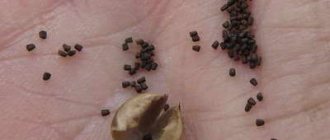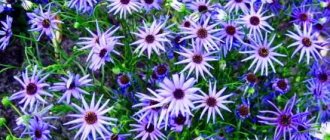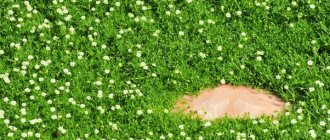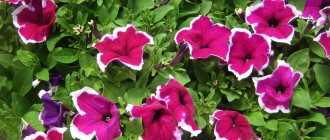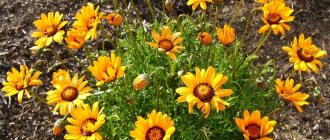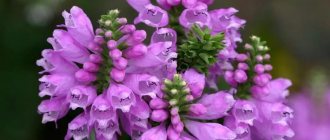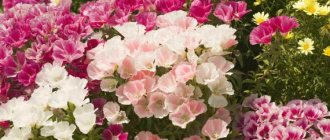Camassia varieties
In terms of external characteristics, Camassia varieties are not much different.
Camassia Cusica
Named after the person who first collected these flowers. This plant is found in the mountains of North America. The peculiarity of the variety is the presence of several bulbs reaching a diameter of 10 centimeters.
The length of Camassia Kuzika reaches one meter, but is mainly located in the range from 60 to 80 centimeters. Camassia forms soft blue inflorescences from 30 to 100 pieces. The stamen of the Kuzika plant is three centimeters long and has a yellow color. Surprisingly fast flowering occurs in the first half of May, taking from a week to 10 days.
Kamassia Leuchtlina
A special feature of the Camassia variety Leuchtlina is the longest (more than five years) growth in one place without transplantation in comparison with other varieties. Flowering occurs at the end of May - beginning of June in the form of a tall plant, reaching 1 meter in length, and ends with the appearance of seed pods.
Noteworthy is the sequence of flowering inflorescences: from the base to the very top. The dying off of leaves occurs at the end of July. The diameter of Camassia Leuchtlina flowers is up to 8 centimeters, the color range is represented by purple, white and lilac flowers. This perennial plant is suitable for adding to food.
Camassia quamash
It has a number of similarities with the Kuzika variety. Firstly, this variety is classified as edible. Secondly, the flowering period is not long (no more than 10 days) and begins in late May - early July. The color scheme is represented by blue, white, and sometimes purple flowers. Habitat: meadows of the United States of America and Canada.
Camassia quamash is considered a low-growing plant with a height reaching 25 centimeters. As a result of selection, the kamash variety of camassia with double inflorescences, in some cases having unusual strokes of white color, appeared in nature.
Blue Melody
Bred for use as decoration, Blue Melody is a perennial, low-maintenance plant that has blue-violet star-shaped flowers located on a peduncle half a meter high. The bright green long leaves are decorated with a white border. Blue Melody is characterized by large bulbs.
Origin and morphological description
Camassia, a still rare guest, can be found on our sites.
But landscape designers have long been attracted to this flower and decorate their gardens with it. Camassia is not picky, has adapted well to our climate, planting and care does not cause difficulties. Given its early flowering, this is an ideal flower for a designer. This plant is native to North America. In wild conditions, camassia grows on the slopes of mountains, well lit by the sun, along river banks, and is an early flowering plant. As soon as the soil thaws, green camassia leaves emerge. The leaves of the crop are green with a grayish tint, have a lanceolate shape (50-60 cm in length). Then stems appear (up to 1 m in height). Inflorescences form on the stem. There are about 100 flowers on each stem.
Camassia in nature
Each flower blooms for only one day, but due to their number, flowering continues continuously for a couple of weeks. The lower buds bloom first, the next day the next ones, and so on until all the buds up to the top of the inflorescence bloom. Camassia petals have different colors:
- blue;
- lilac;
- white;
- creamy white;
- purple;
- violet-blue.
Bright yellow anthers adorn the long filaments. The bulbs of some varieties are quite edible. The Indians readily eat them.
Growing camassia
Growing camassia does not require much work from gardeners. An important point is the following: in dry weather, abundant watering is required. Like all bulbous plants, camassia loves clay, fertile, rich soil.
It is preferable to plant it in an open, consecrated area, but planting it in the shade will extend the flowering period. The flower will be grateful for feeding with mineral fertilizers in early spring.
There are two ways to propagate camassia: through seeds and using bulbs. Since growing a plant through seeds takes a lot of effort and time, the second type of planting is most in demand.
Propagation by seeds
Planting using seeds begins in advance - five months before planting, since camassia requires a period of stratification. The bed is prepared in the fall. Immerse the seeds to a depth of about 2 centimeters, water the bed and cover it with a protective layer of peat. The first flowering should not be expected until 3 years after planting. After 6 years of flowering, a transplant is performed.
Growing from bulbs
The sequence of actions is simple: after the flowering period ends, you should carefully dig up the bulbs and cut out the baby bulbs. Next, we plant in the required areas. It is worth noting the possibility of delaying the planting of dug up bulbs by drying them, but not more than for one month.
When planting using the second method, through the bulbs, a bed is formed with holes up to 20 centimeters, and the distance between them is no more than 15 centimeters. We press parts of the bulb tightly into the ground and water the bed. To prevent frostbite of the bulbs in winter, the soil is filled with peat.
Planting a flower in open ground
- Plot . Sunny is better, but partial shade is also allowed (in it the bushes grow taller, and the flowers stay on the peduncle longer, although fewer bloom in the cluster with minimal sun). It is also important that the corner in which camassia will grow is cozy and protected from draft winds.
- Soil . It can be anything, but preferably not sandy - camassia likes to grow in slightly moist soil. That is, if you have heavy (clayey, chernozem) soil on your site, many other flowers will not survive in it, but camassia will take root just fine.
But at the same time, if puddles constantly collect in the flowerbed (especially in the winter and spring months), the bulb may die. Therefore, it makes sense to put some drainage (gravel, pebbles, expanded clay) into the planting holes.
Before planting, do not forget to ferment the poor soil with peat or humus (you can add 4 to 5 kg of this natural fertilizer per square of soil).
- Time . Late autumn is suitable for both planting bulbs and sowing seeds. Immediately after planting the bulb, water the soil and mulch it with sawdust or dry peat. This procedure will help the tender bulb to survive the winter. It is not necessary if you have a lot of snow in winter, but if the winter promises to be frosty and snowless, it is better not to give up mulch.
- Deepening the bulbs . It depends on the structure of the soil. If it is heavy, deepen the onion by 2 diameters. If it's light, then 3.
The same rules (time, deepening) apply to transplanted camassia, which needs to be renewed every few years.
An important point: the bulbs of this crop are not stored for a long time. Having bought them, immediately cover them with wet peat and send them into the ground as quickly as possible. Having dug up a bush for planting, divide it before planting.
- Working with seeds . Deepen them into the ground by 2 cm. This can be done in late autumn (don’t be afraid of frost - these babies need long-term, five-month stratification). However, there is an opinion that you can send seeds into the ground immediately after ripening (the first half of summer).
An important point: if possible, buy bulbs rather than seeds. The fact is that camassia grown from seeds will bloom in the fourth or even fifth year after germination.
Camassia care
First of all, a flowering plant needs watering , because the most beautiful period of its life occurs during the heat. You need to take out the watering can 2-3 times a week. This should be done in the evening, while warming up the water. But if it rains, watering is not needed.
to feed the flower only if it grows on sandy, light soil. Camassia loam or black soil will have enough nutrients that the soil contains.
It is necessary to apply fertilizing twice: when the camassia sprouts and when its peduncle begins to form. What to buy? Complex mineral fertilizer for flowers (for example, Agricola) or superphosphate.
Also, sometimes you need to look into the flowerbed with a hoe in your hands to remove weeds and slightly loosen the soil .
From June to August, camassia leaves die off , and the flowers fall off even earlier. Do not pull dry bushes out of the ground, do not interfere with the plant’s preparation for winter. It is worth adding a ground cover crop near the camassia. Its task is to hide the sluggish “heaps” into which these bright plants will turn.
Pests and diseases
Camassia bulbs can be parasitized by the onion root mite. You can fight it with the help of an insecticide (for example, the popular “Fitoverma” or something similar).
As for diseases, this flower is afraid of rot. To prevent it from getting sick, even before planting it is worth treating the bulbs with a preventative fungicide solution. If the fungal disease has already begun, treat the flowers with a copper-containing preparation.
Preparing for winter
It is believed that camassia tolerates frost well. But the further north you live, the more important it is to mulch the flowerbed with the bulbs hidden in it. Use fallen leaves, humus or peat, laying them in a layer 5 cm thick. In spring, do not forget to rake this “blanket” in time so that the plant does not dry out under it.
An important point: the older the bulbs, the better they tolerate winter. That is, you can forget to cover a four-year-old camassia, but do not forget to insulate the first-year one.
One more thing: I think it is very important to buy seeds/bulbs grown in your region . The fact is that if you read the websites of different countries, it turns out that in Russia the winter hardiness of camassia is down to -15 degrees, and in England - up to -5 degrees. And it turns out that if you order seed from abroad or simply grown in a warmer area, it may not overwinter well with you.
This is what a camassia blooming in a private flowerbed looks like:
Pests
Rodents and root mites pose a danger to camassia. By mechanical damage to the leaf or plaque on it, you can determine the presence of root mites on the plant. The appearance of mold and rot on the leaves, yellow spots on the bulbs also indicates an attack by parasites.
Soaking the bulbs in hot water for half an hour is a preventive measure that prevents the appearance of mites. To combat parasites, special products are used, available for purchase at any gardening store, but the best option is to get rid of the affected bulbs.
Reproduction
Camassias can be propagated using bulb shoots. It is better to do this in the summer, when they are inactive. Dig them up and dry them at room temperature, but not in the sun, and then set them aside in a cool place. You need to separate the bulbs immediately before planting.
Alternatively, you can collect the seeds. Harvesting should occur when most of the capsules are ripe, have changed color from green to yellowish brown, and have opened to reveal black seeds. This happens in the summer. Dried seeds can be stored in a cool, dry place until planting. The seed usually requires 60-100 days of cold, wet stratification for maximum germination.
Plant care
Camassia needs to be watered deeply as the top layer dries out, two or three times a week. During the dry period, more frequent procedures are required, and after flowering, watering volumes should be reduced.
To ensure the supply of oxygen to the bulbs, careful loosening of the soil is required. Timely removal of weeds will prevent the growth of a perennial plant from slowing down. Provide camassia with mineral and nitrogen fertilizers at the beginning of spring; after the appearance of buds, it is recommended to carry out additional feeding.
Reproduction and planting of camassia bulbs
How to plant camassia bulbs photo
Propagation by daughter bulbs is the most convenient method of propagation. 3-4 years after planting, the main bulb grows about 5-8 daughter bulbs. Dig out the bulb nests after flowering has finished. Until autumn (mid-September), store in a dark place with an air temperature of 20 ° C, the room should be ventilated. Separate the bulbs just before planting. To disinfect, treat in a solution of potassium permanganate.
If the soil is light, plant the bulbs to a depth of 15 cm, if heavy - 10 cm. It is better to plant in small groups so that the plantings look natural.
Camassia in landscape design
The demand for camassia as part of the decor is associated with the beautiful sky-blue hue of the flower. Camassia is the highlight of both the flower garden as a whole, merging into a single complete composition with speedwell and verbena, and as an independent decorative element.
In the shade under the spreading branches of mighty trees, camassia is planted together with geranium, since the latter also tolerates a lack of light without loss. When constructing artificial reservoirs, the use of camassia will be a good solution, giving the structure a more natural look.
A fabulous atmosphere of staying in Canada will be created by planting camassia near coniferous trees. The perennial plant will subtly complement a rocky garden, emphasizing the cold tones of the boulders with even greater coldness of the shades of its inflorescences.
For a long period of time, camassia can be pleasing to the eye while in a vase. Caring for camassia does not require much work, and beginner gardeners can do it. The unusual appearance of this plant will embellish your garden plot.
Variety of species:
There are only 6 species of camassia in the world. Only half is used for cultural cultivation.
Camassia leichtlinii – This species is the most popular. They grow naturally in the western regions of the United States. It has a powerful flowering stem about one and a half meters high. One inflorescence contains 60 beautiful flowers whose diameter is 5 centimeters. They are painted in shades of blue, and sometimes surprise with purple. He does not require transplants or divisions for 5 years of life.
The following varieties have gained particular popularity:
Coerulea – the flowers of this plant are bright blue;
alba - this variety has snow-white petals with a slight shade of green;
Semiplena is a variety with double petals painted in cream shades.
Pink – The pink colors of these large star-like flowers add charm and create a romantic atmosphere in the garden.
Sacajawea is a plant with charming white-to-cream flowers and leaf blades that are colored white along the edges.
Camassia cusickii - in this species, plants can be found both 35 centimeters in height and 100 centimeters. The inflorescence of these plants can contain about 100 flowers of a delicate blue color with a slight shade of lilac. Their diameter is about 3 centimeters. Their natural habitat is the USA. There he chooses a place for himself in mountainous areas at an altitude of 1500 meters. These beautiful flowers must be divided at least once every 3 years due to the rapid growth of the bulbs, which begin to lack nutrition.
The Zwanenburg variety was bred by breeders from Holland. The flowers of this variety are large in size and painted in bright blue colors.
Camassia quamash syn. Camassia Esculenta – the height of this flower is 50 centimeters. The inflorescences, reminiscent of beautiful brushes, are collected from blue, sometimes blue with a violet tint, and sometimes soft blue or white 40 flowers, whose diameter is 4 centimeters.
Varieties of quamassia quamash include:
Blue Melody is a variety with dark blue flowers, stamens sprinkled with gold and green leaves with white edges.
Orion – the height of this beautiful plant is 80 centimeters. When it begins to bloom, it is decorated with dark blue flowers.
Common types. Camassia Cusica
Among the small genus of camassia, there are three types that are most often used in garden design:
- Camassia Kuzika;
- Camassia Leuchtlina;
- kvamash (edible camassia).
Let's start the story with a description of S. Cusickii, that is, Cusick's Camassia. The Camassia Kuzika flower is medium in size. The plant can grow up to 80 cm, but there are low-growing forms that do not exceed 40 cm. This species blooms from mid-May to early June. Although most often the flowering ends by the end of May.
The Camassia Kuzika flower, the photo of which is presented in this article, has a light blue tint. Its bulbs are collected in groups of several pieces. The length of each bulb is approximately 8 cm, and the diameter is no more than 5 cm. One of the features of the species is the unpleasant odor emanating from the bulbs.
The peduncles of Camassia Kuzika stretch up to 80 cm. Of this, 40 cm is occupied by the inflorescence. The leaves are pointed-xiphoid or belt-shaped. The leaf color is bluish-green, the structure is grooved, the edges are slightly wavy. The peduncle raceme contains up to 100 flowers with pointed narrow bracts. The diameter of each flower is approximately 3 cm.
Let's summarize
- Camassia is a decorative flowering outdoor bulbous plant. It is considered a spring plant, but blooms later than other early crops, in the last weeks of May.
- There are five species of this plant. The most commonly seen species in our yards are Camassia Quamash, Kuzika, and Leuchtlina. Each species has popular varieties, differing in the shade of the petals and the duration of flowering.
- The flower is planted in autumn. For camassia, you should choose a lighted or slightly shaded place with moist (but not swampy) soil, as well as, if possible, heavy soil.
Application in garden design
In the field of landscape design, a bulbous plant is highly valued, since its delicacy and rare shades of blue perfectly complement the composition or stand out independently, no less beautifully. Amateur gardeners have recently become very fond of this flower and prefer the Leuchtlina variety.
- This plant looks great in flower beds or as an independent composition; planting it near hedges and coniferous shrubs looks great. In this case, your beauty will be a real princess of the garden, and after it fades, its wilted state will be hidden by the greenery of the bushes.
- Looks great on the banks of a pond, stream or pool. And in order to disguise yellowing foliage, professional designers advise planting bulbs in gardens between bushes of other plants or creating a mix of camassia with reed grass, geraniums, cereals and others.
- If the planting site is on a lawn or in thematic flower beds, then the best neighbors of the plant will be verbena, speedwell or bark.
- Today it is becoming popular to plant group plantings, camassia with geraniums.
Landscape designers increasingly began to pay attention to this plant and use it in their projects. Having examined this culture, we can say with confidence that camassia is one of the best flowers for adding extraordinary beauty to the garden; moreover, it is not demanding of care and needs minimal attention. We wish you success in gardening!
Landscape design, combination with other plants
Camassia in landscape design photo of flowers in mixborder
When growing camassia on the site, keep in mind that soon after flowering ends, the above-ground part dies off completely. At the end of July and beginning of August, the area will become bare - take care of planting crops that will cover the voids.
Camassia Leuchtlina semiplena in landscape design photo
In landscape design, camassia is used taking into account the height of the plant and the color of the corollas.
It is better to plant tall ones in the center of a flower bed, along a fence or structure, and use them for zoning an area. You can plant them in a flower bed, placing them in ascending order so that the plants do not cover each other.
Camassia Leichtlinii Camassia leichtlinii 'Semiplena' photo with decorative onions in a flowerbed
Low-growing plants are planted on alpine hills, in rockeries, and used in border plantings.
Regardless of growth, it can be planted near a body of water, since camassia is not afraid of moisture.
Camassia Kuzika in garden design photo
Camassia plantings look good against the background of conifers and hedges. Suitable partners: aconite, delphinium, aquilegia, geranium, reed grass, speedwell, lupins, combine with ornamental grasses. When creating a semblance of a lawn, combine with verbena and speedwell.
Camassia quamash in the garden photo
As soon as the plant fades, all terrestrial parts also end their vital processes. At the beginning of August, the flowerbed will be empty, so it is better to take care in advance about what flowers will fill the area later.
Camassia is grown taking into account the height of the shoots and the color of the variety. Flower species belonging to the group of tall perennials look good in the center of a flower bed or as a hedge. Plants in the garden look no less attractive if they are planted taking into account their growth. Then the flowers will not cover neighboring plantings.
Tags: camassia, flower
About the author: admin4ik
« Previous entry
Landing
Camassia is planted using two technologies: in open ground and with seeds.
Planting with bulbs
The plant needs cold to grow, so the flower is planted in the ground in the fall. The area needs to be loosened, peat and humus added, mixed and leveled. Baby bulbs are not stored for a long time - after separation they are planted in the ground.
Planting holes are made 15-20 cm deep. The optimal distance between holes for growth is 15 cm. The plant loves drainage - you need to add gravel and small stones to the holes. The soil is ready. The bulbs are planted in holes, covered with soil, watered abundantly, and mulched with sawdust or dry peat. Mulch is necessary to keep the bulbs from freezing in winter.
Sowing seeds in open ground
Camassia can be grown from seeds. They are sown in open ground after being collected in prepared soil to a depth of 2 cm. After sowing, the flowerbed is mulched with compost and peat. During the winter, the seeds are certified and germinate in the spring.

